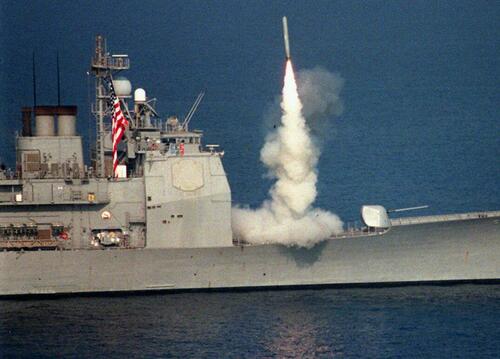Marine Corps Force Design: A Failed Operational Concept
Authored by Gary Anderson via RealClearDefense,
When the Marine Corps adopted a concept called Force Design as its new warfighting concept in 2019, so called military experts hailed it as a groundbreaking adoption of emerging technology. Unfortunately, most of the praise has come from senior Marine leaders in the form of Press releases from the U.S. Marine Corps Communication Strategy and Operations Office, Marine Corps Combat Development Command, Release 002-2020 and ill-informed journalists. On July 6, 2025, the Washington Times published an article by Bill Gertz, ” Marine Commandant: Corps To Focus on Advanced Weapons and Contested Logistics in Prep for War.“
Since that time, things have gone sideways for Force Design. The Tomahawk cruise missiles envisioned proved logistically untenable. The shorter range subsonic NEMSIS anti-ship missiles that the Corps has heavily invested in has become obsolete before being fully fielded while also being vulnerable to Chinese countermeasures. The idea behind Force Design was to hide small units on the many islets and shoals in the south China Sea and along China’s first island chain to interdict passing Chinese warships.
The stunning failure of Force Design is the lack of warfighting and logistics capabilities to operationalize the concept.
To begin with, inlets and islands are not assured locations as they are sovereign to nation states like the Republic of the Philippines that has already stated that the NEMSIS will not be allowed to be used in a conflict with China over Taiwan.
The lack of ability to indiscriminately inhabit islands and inlets along the first island chain is a major blow to Force Design not to mention the inability to logistically support the concept.
The island hopping required to adapt to Chinese movements along the first island chain is improbable at this point with the current conceived Landing Ship Medium (LSM) being too slow and expensive along with the NEMSIS missile system’s lack of mobility and vulnerable to Chinese countermeasures. To date, not one LSM keel has yet been laid.
In other words, the senior Marine Corps leadership made the same mistakes that the French made in developing the Deliberate Battle Doctrine that resulted in the Maginot Line and defeat in 1940, applying the wrong technology at the wrong time and place. They also did it top down with no general debate and without war gaming the worst that the Germans could do, which was to ignore and go around the Maginot Line.
Like the French, General Berger and his minions made it clear that Force Design was sacrosanct and forbidding debate. The only test of French Deliberate Battle doctrine was live fire against the Germans in 1940, failing miserably. The only possible good news for the Marine Corps is that, unlike the Maginot Line, Force Design is hopelessly behind schedule and the operational concept becoming increasingly improbable. Common sense can still prevail as the operational environment in the Indo-Pacific and the rest of the world is constantly evolving.
There was, and still is, an alternative. In the 1990s before 9/11 the Marine Corps was developing a concept called Operational Maneuver From the Sea (OMFTS). It involved launching marine amphibious assaults from over the horizon in column rather than the traditional linear assault waves across isolated landing points such as small beaches and even boat ramps rather than Normandy-like beaches that can easily be identified and defended by a thinking adversary. These relatively small forces would move inland disrupting an enemy force, command and control and opening larger beaches from the rear allowing follow-on Marine Corps and Army forces to create more traditional lodgments ashore.
General Berger came to believe that OMFTS was obsolete because of the increasing sophistication of the largely land based Chinese Anti Access/Access Denial systems, which the Soviets called a Reconnaissance-Strike Complex would become so effective that it would make amphibious operations impossible.
Berger failed to read the reports of his own Marine Corps Warfighting Lab. Back in the late1990s when I was the Lab’s Chief of Staff, we partnered with the late Andrew Marshall the Director of the DoD Office of Net Assessment to play a series of computer assisted war games in 2030. We gave the Chinese credit for a very sophisticated Reconnaissance-Strike concept that included loitering drones and satellite reconnaissance. These linked to the kind of mobile land-based hypersonic mobile launchers as well as missiles in hardened shelters that we knew the Chinese were developing and now have. We also gave them credit for fast moving anti-ship seaborne drone mines.
We postulated that to have aircraft carriers and amphibious ships operate in the South China Sea, we would have to disrupt the Chinese Recon-Strike complex, we would need bunker busting bombs for the hardened sites. This actually happened with the development of the the deep penetrating bombs recently used against Iranian nuclear sites.
The mobile launchers were a more difficult problem. Our solution to this was something we called the Reconnaissance-Surveillance-Target Acquisition (RSTA) Cloud. This would consist of dropping swarms of small-to-micro robotic sensors to every point where a missile launch was detected near-immediately by loitering drones. This system would allow these covert micro systems to track and target the mobile launchers for destruction by air and sea launched U.S. military assets.
We envisioned setting up a series of decoy maritime targets of various types to draw Chinese fire before actual U.S. surface combatants were committed allowing the launchers to be tracked and destroyed. This would allow U.S. Sea control to enable power projection against Chinese combatants as well as to enable OMFTS amphibious operations.
In the computer games, we believed that the Chinese Recon-Strike Complex could be disrupted enough to allow us to operate in the South China Sea in the 2030s, but I believed that OMFTS and the ground oriented RSTA Cloud was feasible by 2020 for use against threats like the Iranians and the Houthis.
If swarms of the small robots could be emplaced at key road intersections, bridges, and other choke points we came to believe that the RSTA Cloud could also identify surfaces and gaps in enemy defenses allowing our forces to disrupt them using maneuver warfare.
We also did a series of force-on-force ground experiments using surrogates for the micro sensors that we knew the Defense Advanced Research Projects Agency (DARPA) was developing. These included a sea based OMFTS operations off Okinawa.
Unfortunately, 9/11 happened along the way. As the wars in Iraq and Afghanistan consumed more Marine Corps attention, OMFTS and its supporting projects went on the back burner. By 2019, as the wars in Iraq and Afghanistan were winding down, many of us now retired OMFTS advocates hoped that the Marine Corps would return to it offensive amphibious roots. General Berger had vastly different ideas, and now we have Force Design.
Force Design has proven to be far too expensive and inviable. Implementing Force Design forced the Marine Corps to divest themselves from much of the combat power that made it a world class crisis response force. However, many of the capabilities required for OMFTS (V-22, Osprey, Navy LCAC and CH-53E helicopter) are still in the Marine Corps’ inventory. Once in mass production, the micro sensors to counter the RSTA Cloud would be infinitely less expensive than the missile and radars needed to implement Force Design. Despite this, the current Marine Corps Leadership has doubled down on Force Design. It will take new leadership to steer the Marine Corps back on course to regain the title as the world’s premier global force in readiness.
Gary Anderson retired as the Chief of Staff of the Marine Corps Warfighting Lab and served as a Special Advisor to the Deputy Secretary of Defense. He recently retired as an Adjunct Professor at the George Washington University’s Elliott Scholl of International Affairs.
Tyler Durden Wed, 07/30/2025 – 20:55
Source: https://freedombunker.com/2025/07/30/marine-corps-force-design-a-failed-operational-concept/
Anyone can join.
Anyone can contribute.
Anyone can become informed about their world.
"United We Stand" Click Here To Create Your Personal Citizen Journalist Account Today, Be Sure To Invite Your Friends.
Before It’s News® is a community of individuals who report on what’s going on around them, from all around the world. Anyone can join. Anyone can contribute. Anyone can become informed about their world. "United We Stand" Click Here To Create Your Personal Citizen Journalist Account Today, Be Sure To Invite Your Friends.
LION'S MANE PRODUCT
Try Our Lion’s Mane WHOLE MIND Nootropic Blend 60 Capsules
Mushrooms are having a moment. One fabulous fungus in particular, lion’s mane, may help improve memory, depression and anxiety symptoms. They are also an excellent source of nutrients that show promise as a therapy for dementia, and other neurodegenerative diseases. If you’re living with anxiety or depression, you may be curious about all the therapy options out there — including the natural ones.Our Lion’s Mane WHOLE MIND Nootropic Blend has been formulated to utilize the potency of Lion’s mane but also include the benefits of four other Highly Beneficial Mushrooms. Synergistically, they work together to Build your health through improving cognitive function and immunity regardless of your age. Our Nootropic not only improves your Cognitive Function and Activates your Immune System, but it benefits growth of Essential Gut Flora, further enhancing your Vitality.
Our Formula includes: Lion’s Mane Mushrooms which Increase Brain Power through nerve growth, lessen anxiety, reduce depression, and improve concentration. Its an excellent adaptogen, promotes sleep and improves immunity. Shiitake Mushrooms which Fight cancer cells and infectious disease, boost the immune system, promotes brain function, and serves as a source of B vitamins. Maitake Mushrooms which regulate blood sugar levels of diabetics, reduce hypertension and boosts the immune system. Reishi Mushrooms which Fight inflammation, liver disease, fatigue, tumor growth and cancer. They Improve skin disorders and soothes digestive problems, stomach ulcers and leaky gut syndrome. Chaga Mushrooms which have anti-aging effects, boost immune function, improve stamina and athletic performance, even act as a natural aphrodisiac, fighting diabetes and improving liver function. Try Our Lion’s Mane WHOLE MIND Nootropic Blend 60 Capsules Today. Be 100% Satisfied or Receive a Full Money Back Guarantee. Order Yours Today by Following This Link.







